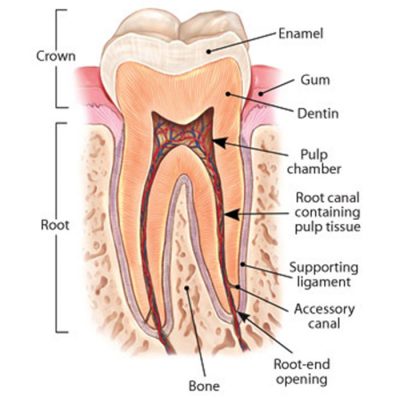
Root canal treatment or endodontic treatment

The many causes include deep tooth decay , repeated or traumatic dental procedures or trauma to a tooth resulting in a crack or root fracture that allows bacteria to infiltrate into the pulp. Gum diseases can also result in loss of tooth vitality although this will occur when the gum disease is at a very advanced stage.
The general symptoms of root canal infections are
1)Pain on biting
2)Sensitive to hot and cold foods and the pain lingers on
3)Sharp acute intense pain
4)Dull ache and pressure
5)Swelling of gums around the root area of the tooth.
Contrary to many laypeople perceive about root canal treatment, ENDODONTIC TREATMENT DOES NOT CAUSE PAIN – IT RELIEVES PAIN ! With modern techniques and anaesthetics, most patients are comfortable during the root canal treatment by an endodontist. In most cases , you get immediate relief of pain . In severe pain or infection cases, although there is a lot of pain reduction after endodontic treatment, your tooth will feel a bit sensitive for a few days . This discomfort can be easily relieved with analgesics prescribed by your endodontist.

When the pulp is inflamed , it swells and this increases the pressure inside the tooth. As the pulp is in a confined space inside the tooth , the pressure rises rapidly resulting in the severe pain. Eventually, the pulp dies and the tooth becomes infected.

1) The endodontist begins the procedure by numbing the tooth with a strong local anesthetic. As a result the tooth and the surrounding gum areas are completely numb ,resulting in painless comfortable root canal treatment procedures.
2) A small opening is made on the chewing surface of your tooth to allow the endodontist to gain access to the pulp. Very small and delicate rotary instruments are used to remove the dead and dying tissues and to clean and disinfect the root canal system.

3) The root canals are shaped and prepared so that the endodontist can seal the root canal system with a biocompatible root filling material. These are sealed with root canal cement so as ensure that there is no micro leakage so as to prevent future infection.
In most cases a core build up and crowning is required to protect the tooth from splitting .
The tooth is strengthen with a core build up and the crowning is done with the prosthodontist who is the specialist in tooth reconstruction and replacement
Root canal specialist or endodontist are dentist who have completed additional two or three years of advance postgraduate training in the field of endodontics.
Endodontist are trained in the diagnosis and treatment of diseases of the dental pulp and their management of pain . The goal of an endodontist or root canal specialist is to treat an inflamed or infected tooth focusing on removable of infection, eliminating pain and finally to save the tooth.
Advanced training- endodontists have to undergo an additional 2 to 3 years of intensive training in root canal treatment. They are trained to treat complex cases and their complications. They are trained in pain management and techniques to minimize pain during root canal treatment.
Experience and efficiency. Since root canal specialists limit their practice to solely endodontic treatment, they have considerable experience in such work.
Advanced technology . Endodontists use operating microscopes for their root canal work . This enable them to see and manage the smallest minute details in the root canal system of a tooth. They also utilize digital imaging instead of conventional analog xrays. Digital imaging is faster with a very much reduced radiation dosage to the patient.
Pain management. Root canal specialists are well trained in the various techniques of pain management. As such , getting endodontic treatment is often no more uncomfortable than having a filling done . With very anxious patients, the root canal treatment can be done under i.v sedation with an anaesthetist.
In Singapore, all specialists in endodontics have to be board certified by the Singapore Dental Council. Those who are certified by the Singapore Dental Council will be allowed to have the title “Endodontist or Specialist in Endodontics” after their name.
After going through your medical history , the endodontist will take some xrays of your teeth.
The tooth in question will be thoroughly examined by the endodontist under the operating microscope. He will assess whether your tooth requires root canal treatment and more importantly whether the tooth is restorable after root canal treatment. Contraindications for root canal treatment includes teeth that do not have enough tooth structure for crowning or when there is presence of fractures in the root.
The tooth is then thoroughly numbed and root canal treatment can begin almost immediately. In most cases, the treatment can be done in one visit , but in complex case, two to three visits may be required.

B.D.S. (Singapore), 1994
M.Sc. Endodontics (London), 1997
F.A.M.S. Endodontics, 2013
